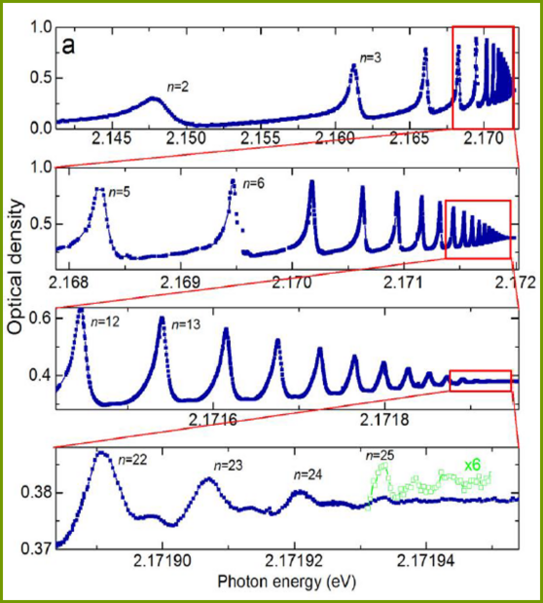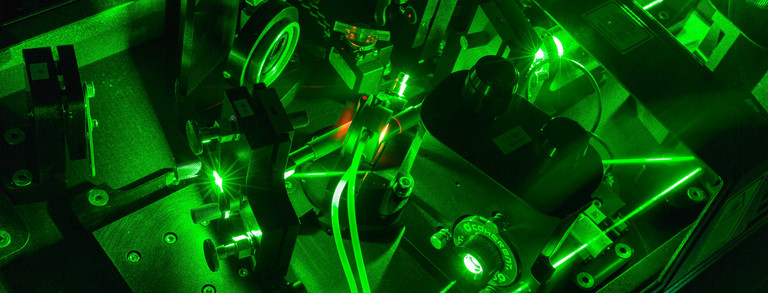High Resolution Spectroscopy
Due to fast carrier dephasing and relaxation, in solid state systems a few μeV resolution are sufficient for most optical experiments. One focal point of Experimental Physics 2 is finding semiconductor structures, where these mechanisms are suppressed. One example is the yellow 1S exciton series in cuprous oxide with linewidth ≤ 1 μeV. In an experiment such narrow linewidth can directly be observed with high resolution spectroscopy techniques.

The combination of narrow linewidths and a large exciton binding energy of about 90 meV allows us to observe and investigate Rydberg excitons, which are the semiconductor analogues of Rydberg atoms: Atoms, where at least one of the electrons is excited into a state with huge principal quantum number n. As the spatial extension, polarizability and dipole interactions of such states scale non-linearly with n, Rydberg states show exaggerated properties. We have observed Rydberg excitons with principal quantum numbers as large as 25, which corresponds to excitons with a spatial extent of 2 μm - the equivalent of more than 10 billion crystal unit cells or 10 times the wavelength of the excitation laser inside the crystal. Due to the strong interaction between excitons with large n, a phenomenon called Rydberg blockade occurs: The presence of excitons shifts the energy needed to excite further excitons and therefore results in a blockade effect, which is a cornerstone of quantum information technology. Whether it is possible to realize such strong interactions that the presence of a single exciton is sufficient to completely prevent the excitation of further excitons is a subject of current research.
In our lab there are a dye-laser (res 1MHz) and a TiSaphire-laser (res 100kHz) available for high resolution transmission experiments. Additionally luminescence is detected with a CCD behind a double monochromator. For use in second order the overall resolution of these devices is 10µeV. Such a high resolution is useful only for cooled solids. This is done with various cryostats for different applications. In time resolved measurements we use an electro-optical modulator for the creation of laser pulses with variable shapes
Current Offers For Bachelor-, Master- or PhD-Theses
We offer Bachelor- and Master-theses in relation to the ongoing research. Feel free to come to our offices and ask someone of the team for more information.
Contact
- Jun.-Prof. Dr. Marc Aßmann
- Prof. Dr. em. Dietmar Fröhlich
- Dr. Julian Heckötter
- Martin Bergen
- Binodbihari Panda
Collaborations
-
AG Halbleiteroptik, Universität Rostock
-
AG Quantenoptik makroskopischer Systeme, Universität Rostock
-
Ioffe Physical-Technical Institute, Russian Acadamy of Sciences



